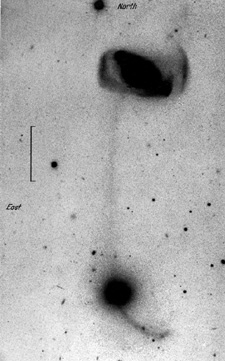


B. KEENAN's System
Long before the recent development on double galaxies gathered momentum, P. C. KEENAN had noticed the remarkable filament between the peculiar type spiral NGC 5216 and the globular galaxy NGC 5218. His note (29) on this system seems to have been overlooked by most of the workers in the field. This fine double galaxy was subsequently "rediscovered" by observers at the Lick and Palomar observatories which resulted in a merry confusion until it was pointed out to us by G. DE VAUCOULEURS, N. U. MAYALL and others that KEENAN fifteen years previously had pointed out its existence. A photograph taken by the author with the 200-inch telescope is reproduced in Plate III.

|
Plate III. KEENAN'S system, NGC 5216-5218 at R.A. 12h 30m 30s and Decl. +62° 59'. 200-inch photograph, exposure 30 minutes on blue sensitive Eastman 103a-0 plate. Scale indicates one minute of arc. |
While there hovers a mass of luminous "debris" around and in between the two galaxies, the most remarkable structures are the concentrated stringlike formation connecting the two stellar systems as well as the fingerlike extension or "countertide" protruding from the globular NGC 5218 and starting on the same tangent as the interconnecting filament, a constellation which as we have mentioned before occurs rather frequently. It is likewise a common feature of many connected double nebulae that only one of them shows a distinct countertide. At my request Dr. N. U. MAYALL at the Lick Observatory this summer photographed the spectrum of KEENAN'S system. His preliminary results for whose communication I am indebted to him are as follows.
NGC 5216.
Vs = +2905 km/sec, as obtained from both absorption
and emission lines. Among the latter
 3727 is prominent.
3727 is prominent.
NGC 5218. Vs = + 2883 km/sec, with no emission lines detectable.
The values of Vs have not been corrected for solar motion. Dr. MAYALL writes further "I see no suggestion on the plate of any nebular emission lines, particularly 3727, in the connecting link. It is possible that a plate taken under better conditions, without having to run to 6 1/2 western hour angle, might show something, but I doubt it." Using HUBBLE's old distance scale with an average value of 550 km/sec for Vs per every million parsecs, the distance of KEENAN's system is 17.3 million light years. The separation of the two components follows as about 22000 light years. The photographic apparent magnitude of the spiral galaxy may be estimated as +13.3. With the distance modulus of 28.6 this corresponds to absolute photographic magnitudes mp = -15.3. The globular member is somewhat fainter. No resolution of any kind has so far been detected with the 200-inch telescope a result which is reasonable in view of the fact that KEENAN's system is more than twice as distant as the Virgo cluster. As in all other cases, it will be worthwhile to make further attempts at obtaining spectrograms of the faint luminous intergalactic formations in KEENAN's system. So far it can only be said that these appear blue and show no emission lines, from which fact we conclude that they consist of stars.